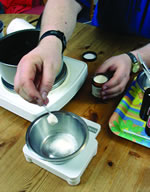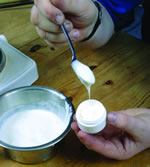Positive Health Online
Your Country

Make Your Own Natural Skin Care Products
by Kolbjorn Borseth(more info)
listed in skincare, originally published in issue 99 - May 2004
Throughout the ages, people have used natural and locally sourced raw materials to create their own skin care products. The American Indians used and still use Jojoba oil for skin care, soaps, cooking and as a natural medicine. In Africa, they used and still use shea-butter and coconut-butter. Around the Mediterranean they used and still use olive oil. In Northern Europe and especially in Britain these plants do not grow so well so we have used animal fats and tallow. However, as fatty acids store all of the heavy metals from pollution (such as lead), it is no longer wise to use animal fats.
Oil Products
With the development of the oil industry in America, by-products such as Vaseline (petroleum jelly) and paraffin oil are now used in most skin care creams, medical creams and ointments. These cannot be absorbed by healthy skin and they create a thin film on the surface of the skin, blocking the pores and preventing the skin from functioning normally. They do not contain any vitamins, and disturb or even stop the skin from being able to absorb fat-soluble vitamins. They are very detrimental to the skin with long-term use. Mineral oils appear to moisturize the skin, but in reality they suppress its normal, healthy functioning. The skin then becomes 'dependent' on constant applications of mineral oil, which, in turn, results in a deterioration of the skin's character and ability to keep itself healthy. However, they do not contain any fatty acids and don't go rancid. If you have a product, which is more than two years old, it is based on mineral oils.
Vegetable Fats and Oils
Vegetable fats and oils are readily absorbed by the skin and are used to nourish (give energy to) the skin/body. They are needed to create new cells and for other important processes in the body. Most vegetable oils contain vitamins, which are necessary for the skin (such as pro A, D and E), and are good for the skin. They can stimulate the skin to function better and create better circulation. They soften the skin and make it pliable, helping it to retain its own moisture more effectively. They contain the essential fatty acids, which go rancid after a time. It is clear from this that natural vegetable oils can actually help the skin to function better. Often they will even help to resolve some of the simpler skin problems, e.g. irritation of the skin caused by soaps, cosmetics, clothes or deficiencies in fats or vitamins in the skin. Vegetable oils and fats consist of glycerine, fatty acids, fat-soluble vitamins (where applicable) and other fat-soluble ingredients. The fatty acids can also be subdivided into four categories:
Saturated fatty acids
Saturated fatty acids are solid at room temperature (e.g. stearic acid), and become a thick liquid inside our bodies. These fatty acids are the ones which are supposed to be responsible for vascular and heart disease when consumed in large quantities. They are absorbed slowly by the skin and are added to give massage and skin oils more lubrication. In face oils they make the skin's own oils even oilier.
With oily skin the presence of these fatty acids will mean that the pores become more easily blocked which will cause them to enlarge. These fatty acids keep well and do not go rancid so quickly. Saturated fatty acids are found primarily in animal fats such as lard and tallow but they are also found in coconut-butter, cocoa-butter and shea-butter.
Mono unsaturated fatty acids
Mono unsaturated fatty acids are liquid at room temperature. The most common monounsaturated fatty acids are those oleic acids found in most oils. Oleic acids keep well.
Duo and Polyunsaturated fatty acids
Duo and poly unsaturated fatty acids, include linoleic (duo) and linolenic acid (poly). Linolenic acid is the one most disposed to becoming rancid. They are thin liquids, which are quickly absorbed by the skin. They are 'drier' than the other fatty acids. Because they have a tendency to go rancid easily, they often need added Vitamin E as an anti-oxidant. Duo- and polyunsaturated fatty acids combine with the fats and oils in the skin to make them thinner and help in reducing the size of pores. They act like vitamins for the skin. The most important fatty acids are the essential ones, which in some countries are known as Vitamin F.

Measuring the ingredients

Pouring the cream into jars
Blending the oils
Mixing the different vegetable oils can create a blend of oils, which is better suited to the particular purpose for which it is intended than the simple use of one or other oil. Get to know the different oils and their characteristics. Test them on your own skin to learn how they feel and how quickly they are absorbed by the skin. Then try making your own blends. Test them in the crook of your arm first, to test for any possible allergic reaction, and then use on those body parts you have made them for. Store your vegetable oils in the fridge. Make up small quantities of your blends so they don't have to stand for too long before being used. Store these at room temperature.
Vitamin E/Tocopherols
Vitamin E is the name given to several tocopherols of which alpha-tocopherol is the most active. Alpha-tocopherol can be produced chemically (dl-alpha-tocopherol) or be extracted from soybeans and sunflower oil, for example. Natural Vitamin E is 1.36 gr. It is more reactive than its chemically produced counterpart with the same vitamin content. The tocopherols operate and are active both in the product and on the person's skin and inner organs. The need for tocopherols in products or in the human body will depend on the amount of compounds prone to oxidisation such as polyunsaturated fatty acids, which are present. The more polyunsaturated fat one eats, the more tocopherol one will need. Similarly the more polyunsaturated fat in a product, the more tocopherol it will need to contain.
Tocopherols protect against the side effects of radiotherapy and cytotoxins. Free radicals are formed during exposure to sunlight, during the breaking down of environmental pollutants and during the oxidation of oils when exposed to heat or sunlight. Vitamin E applied to the skin will penetrate it and take care of the free radicals. The vitamin will absorb the sun's dangerous ultra-violet rays, which are responsible for the reddening of the skin, sunburn and more serious burns. Ultra-violet rays and the free radicals age the skin more quickly reducing its elasticity and creating wrinkles.
Vitamin E therefore works to prevent wrinkles, stimulates the blood circulation and regulates the skin's elasticity. 0.5% E-vitamin oil is only enough to be an anti-oxidant for the product ingredients. For skin protection you need to increase the amount from 2-3% up to 30%. This can easily be blended into your base oil. Applying up to 30% E-Vitamin Oil keeps the skin in good condition and actually increases the growth of new skin cells. It also increases the circulation, so don't worry if your skin gets slightly reddish. You can safely use up to around 50% E-vitamin oil. It is a greasy substance, so if you have oily skin you need to combine it with a high dosage of thin dry vegetable oil.
Wheatgerm
In this country people tend to use wheatgerm as an anti-oxidant. However wheatgerm from factories goes rancid within a few weeks. This is because it contains very little E-Vitamin Oil (0.4-0.5%). It has a large amount of linolenic acid that makes this rancidity process even faster. This is why the smell of wheatgerm is normally so bad. A rancid product accelerates the rancidity process of the skin and through that we get wrinkles.
Please Note: The recipes are not listed on this web page but are listed in the printed version of the magazine.
Comments:
-
No Article Comments available